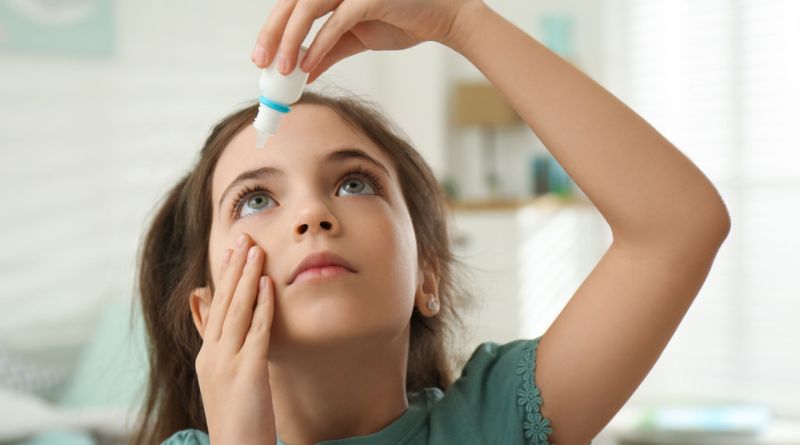
As parents, we always want the best for our children, especially when it comes to their health and well-being. If your child has eye irritation, dryness, or an infection, you may be considering using eye drops for kids to provide relief. However, it’s important to know that not all eye drops are suitable for children, and understanding how to use them properly can make a big difference in your child’s comfort and recovery.
Table of Contents
In this article, we will explore everything you need to know about eye drops for kids, including when they are needed, how to use them correctly, potential side effects, and the types of eye drops available. Additionally, we will answer some common FAQs to help guide you in choosing the best option for your child’s eye care.
What Are Eye Drops for Kids?
Eye drops for kids are a type of medication that is applied directly to the eye to treat various conditions. These drops can help relieve discomfort caused by dry eyes, allergies, infections, or other eye conditions. Some eye drops for kids are available over-the-counter, while others require a prescription from a pediatrician or ophthalmologist.
In general, eye drops for kids are formulated to be gentle on young eyes. They often have fewer chemicals and preservatives compared to adult eye drops, making them safer for children. When used correctly, eye drops for kids can provide effective relief and promote faster healing.
When Do Kids Need Eye Drops?
There are several common reasons why a child may need eye drops. Here are some of the most frequent conditions that can be treated with eye drops:
1. Allergies
Children who suffer from allergies may experience itchy, red, or watery eyes. These symptoms can be triggered by environmental factors such as pollen, dust, or pet dander. Eye drops for kids designed to treat allergies can help reduce inflammation and relieve the discomfort caused by allergic reactions.
2. Dry Eyes
Dry eyes occur when there is insufficient lubrication on the surface of the eye. This can be caused by prolonged screen time, environmental factors like wind or smoke, or underlying health conditions. Artificial tears or lubricating eye drops for kids can provide much-needed moisture to the eyes and alleviate dryness.
3. Conjunctivitis (Pink Eye)
Conjunctivitis, commonly known as pink eye, is an infection or inflammation of the conjunctiva, the clear membrane that lines the inside of the eyelids and covers the white part of the eye. It can be caused by a viral or bacterial infection or even an allergic reaction. If your child has pink eye, eye drops for kids can help treat the infection or reduce inflammation and redness.
4. Eye Infections
Sometimes, children can develop infections in their eyes due to bacteria or viruses. These infections can cause symptoms like redness, discharge, or discomfort. Depending on the cause of the infection, a doctor may prescribe antibiotic or antiviral eye drops for kids to clear up the infection and prevent complications.
5. Eye Strain
With increased screen time, children can suffer from eye strain, especially after reading, using a tablet, or watching TV for extended periods. If your child is experiencing fatigue, blurred vision, or irritation, lubricating eye drops for kids can help relieve some of the discomfort associated with eye strain.
Types of Eye Drops for Kids
There are different types of eye drops for kids, and the type you choose depends on the specific condition your child is experiencing. Here are the most common types of eye drops:
1. Lubricating Drops (Artificial Tears)
Lubricating drops, often referred to as artificial tears, are the most commonly used eye drops for kids. These drops help add moisture to the eyes and relieve symptoms of dry eyes, eye strain, or irritation. They are available over-the-counter and are safe for children. However, it’s important to choose preservative-free options for young children to avoid irritation.
2. Antihistamine Eye Drops
If your child’s eye symptoms are caused by allergies, antihistamine eye drops for kids can be very effective. These drops work by blocking the release of histamine, the substance responsible for allergy symptoms like itching and swelling. These drops are usually available over-the-counter, but if the symptoms are severe, a pediatrician may recommend a prescription option.
3. Antibiotic Eye Drops
When a child has a bacterial eye infection, such as conjunctivitis, antibiotic eye drops for kids can help clear the infection. These drops require a prescription from a doctor and are formulated specifically for children’s sensitive eyes. It’s important to follow the doctor’s instructions carefully to avoid complications.
4. Steroid Eye Drops
Steroid eye drops for kids are used to reduce inflammation in the eyes. They are typically prescribed for more serious conditions, such as inflammation due to allergies or other medical conditions. Steroid eye drops should only be used under the guidance of a healthcare professional, as they can have side effects if used improperly.
5. Decongestant Eye Drops
These drops are used to reduce redness caused by irritation or allergies. They work by constricting blood vessels in the eyes, leading to less redness. However, they should be used with caution and only under the recommendation of a doctor, as overuse can lead to increased redness or other side effects.
How to Use Eye Drops for Kids Effectively
Using eye drops for kids can sometimes be challenging, especially if your child is young or reluctant to have the drops put in. Here are some tips to make the process easier and more effective:
1. Wash Hands First
Before administering any eye drops, always wash your hands thoroughly to avoid introducing bacteria to your child’s eyes.
2. Position Your Child Properly
For younger children, it may be helpful to have them lie down with their eyes closed. You can gently pull down their lower eyelid to create a small pocket. For older children, they can sit or stand with their head tilted slightly backward.
3. Instill the Drops
Hold the dropper a few inches above your child’s eye and gently squeeze the bottle to release one drop into the eye. Be careful not to let the dropper touch the eye or eyelashes to prevent contamination.
4. Close Eyes and Blink
After administering the drops, encourage your child to gently close their eyes and blink several times to spread the drops evenly across the eye. If needed, you can repeat the process for the other eye.
5. Follow the Recommended Dosage
Be sure to follow the recommended dosage and frequency as instructed by your child’s doctor or on the product packaging. Overuse of some eye drops for kids can lead to side effects.
Possible Side Effects of Eye Drops for Kids
While eye drops for kids are generally safe when used correctly, there are some potential side effects to be aware of. These include:
- Eye irritation: Some children may experience stinging, burning, or discomfort after applying the drops.
- Allergic reactions: In rare cases, children may be allergic to the ingredients in the eye drops, leading to redness, swelling, or itching.
- Blurry vision: Some drops may temporarily blur vision after use. This usually clears up after a few minutes.
- Increased eye redness: Overuse of decongestant drops can sometimes lead to increased redness or irritation.
If you notice any severe reactions, such as swelling, persistent irritation, or unusual discomfort, contact a healthcare professional immediately.
Frequently Asked Questions About Eye Drops for Kids
1. Can I use adult eye drops for my child?
No, adult eye drops may contain ingredients or preservatives that are not safe for children. Always use eye drops specifically designed for kids, or consult with a pediatrician before using any adult products.
2. How often should I use eye drops for kids?
The frequency depends on the type of drops and the condition being treated. Always follow the instructions on the packaging or the advice given by your child’s doctor.
3. Are there natural alternatives to eye drops for kids?
Some parents prefer natural remedies like using warm compresses or saline eye solutions for mild eye irritation. However, for more serious conditions like infections or allergies, it’s important to use the appropriate medicated drops prescribed by a healthcare professional.
4. What should I do if my child refuses to take eye drops?
If your child is reluctant to use eye drops, try to make the experience as comfortable as possible. You can make it a game, offer rewards, or let them help with the process. You may also want to seek advice from your child’s doctor or pediatrician if the refusal continues.






